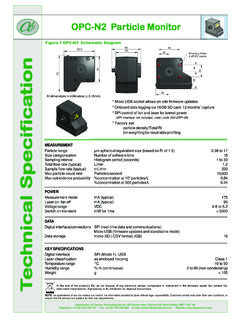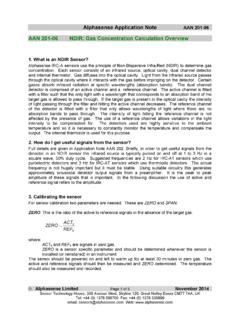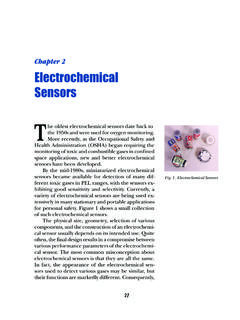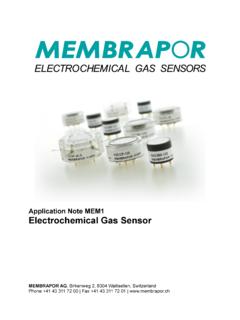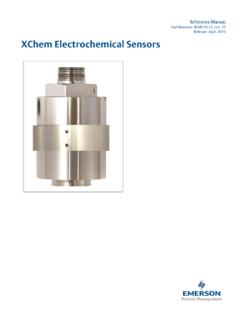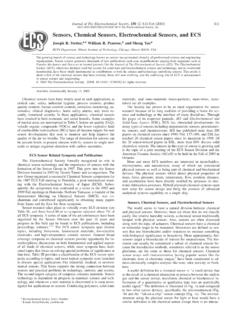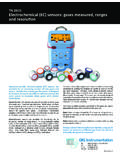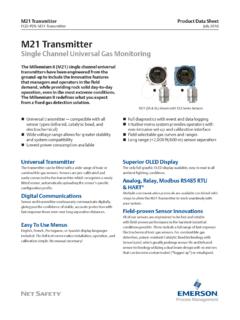Transcription of AAN 104 How Electrochemical Gas Sensors Work
1 Alphasense Application Note aan 104 Alphasense Ltd Page 1 of 4 Issue 12 sensor Technology House, 300 Avenue West, Skyline 120, Great Notley. 7AA. UKTel: +44 (0) 1376 556700 - Fax: +44 (0) 1376 335899 Email: - Web: 104 How Electrochemical Gas Sensors WorkAlphasense toxic gas Sensors are Electrochemical cells that operate in theamperometric mode. That is, they generate a current that is linearly proportional tothe fractional volume of the toxic gas, such as CO or H2S. Figure 1 showsschematically the structure of a toxic gas 1. Schematic diagram of Electrochemical toxic gas sensor . Three metal stripsconnect each electrode to the three pins outside of the sensor electrodes in a toxic gas sensorThe working electrode (also called the sensing electrode) is designed to optimisethe oxidation or reduction of the toxic gas to be measured.
2 This electrode allows thegas to come in contact with both electro catalyst and electrolyte to create a three-phase interface of gas, liquid and other two electrodes in the cell, the counter electrode and the referenceelectrode usually have a similar chemical composition to the working electrode. InAlphasense Sensors all three electrodes are stacked parallel to each other, asillustrated in Fig. cell electrolyte provides ionic electrical contact between the electrodes, usuallywith the aid of hydrophilic separators (labelled wetting filters in figure 1) to allowcapillary transport of the electrolyte which is usually sulfuric acid between 3 and Application Note AAN 106 for further information. A potentiostatic circuitmaintains the potential of the working electrode at a fixed value with respect to thereference electrode potential.
3 See Application Note AAN 105 for more information onelectronic circuit working electrode is the surface where the Electrochemical oxidation (CO, H2S,NO, SO2) or reduction (NO2, Cl2) occurs. A high surface area catalyst is used tooptimise the sensor performance, resulting in a high sensor capacitance: typically 50to 200mF, leading to susceptibility to electromagnetic interference; see ApplicationNote AAN ElectrodeReference ElectrodeCounter Electrode Gas diffusion barrierElectrolyteReservoirWettingfilter s Alphasense Application Note aan 104 Alphasense Ltd Page 2 of 4 Issue 12 sensor Technology House, 300 Avenue West, Skyline 120, Great Notley. 7AA. UKTel: +44 (0) 1376 556700 - Fax: +44 (0) 1376 335899 Email: - Web: electrode is exposed to the outside air and hence is directly exposed to allgases in the air including the gas to be measured.
4 Therefore this electrode may bepoisoned if exposed to certain gases that either adsorb onto the catalyst ( onto CO Sensors ), or react, creating by-products which inhibit the catalyst( NO2 or aromatics onto H2S Sensors ). This is the same problem as poisoning infuel cells and car catalytic counter electrode balances the reaction of the working electrode if theworking electrode oxidises the gas, then the counter electrode must reduce someother molecule to generate an equivalent current, in the opposite sense. Forexample, where carbon monoxide will be oxidised on the working electrode, oxygenwill be reduced on the counter electrode. The two reactions are:Working electrodeCO + H2O CO2 + 2H+ + 2e-Counter electrode1/2O2 + 2H+ + 2e- H2 OThe overall cell reaction is:CO + 1/2O2 CO2 The higher the CO concentration the harder the counter electrode must work to keepup and hence the more oxygen it will consume at the counter electrode.
5 Unlike theworking electrode, the counter electrode potential is allowed to vary. The counterelectrode potential in clean air is close to the working electrode, but as current isdemanded from the counter electrode, the potential increases, so the mainresponsibility of the potentiostat circuit is to ensure that adequate current is fed to thecounter electrode and that the counter electrode can operate at its for most Sensors reduction of oxygen at the counter electrode is the mostcommon reaction the counter electrode will do whatever it must do to keep up withthe working electrode. At low gas concentrations the working electrode produces asmall current and hence the counter electrode quite easily reduces small amounts ofoxygen to maintain the Electrochemical balance, but If the sensor is starved ofoxygen (for example when measuring H2S in biogas where the oxygen concentrationis a few hundred ppm) then the counter electrode will begin to reduce protons,generating hydrogen gas when it runs out of oxygenAlphasense toxic gas Sensors are three electrode systems: they include a thirdelectrode, the reference electrode.
6 This reference electrode anchors the workingelectrode potential to ensure that it is always working in the correct region of thecurrent-voltage curve see figure 2 below. It is important that the referenceelectrode has a stable potential, keeping the working electrode at the rightelectrochemical potential to maintain a constant sensitivity, good linearity andminimum sensitivity to interfering gases. The potentiostat circuit described inApplication Note AAN 105 ensures that the counter electrode is provided with asmuch current as it needs, also maintaining the working electrode at a fixed potential,irrespective of how hard it is working. Alphasense Application Note aan 104 Alphasense Ltd Page 3 of 4 Issue 12 sensor Technology House, 300 Avenue West, Skyline 120, Great Notley.
7 7AA. UKTel: +44 (0) 1376 556700 - Fax: +44 (0) 1376 335899 Email: - Web: voltage curvesThe working electrode current changes when the applied potential is varied,producing a current-voltage curve; a schematic diagram of a typical current voltagecurve is shown in Figure 2. Schematic diagram of a typical current-voltage , note that there is a plateau region up to several hundred millivoltswhere the generated current is almost independent of the applied potential. Thisregion of the current-voltage curve is known as the diffusion or transport limitedcurrent plateau. This plateau occurs because the current is controlled completely bythe diffusional flux or mass transport of the electroactive gas (for example CO or H2S)to the working electrode; this flux is independent of the potential applied to theelectrode.
8 On either side of this plateau region the current is controlled by theelectrochemical kinetics at the electrode/electrolyte interface and the current in theseregions is exponentially dependent on the electrode potential. The toxic gas sensorshould be operated with the working electrode potential in the diffusion limitedplateau region so that the output current is not critically sensitive to the appliedpotential, or to small fluctuations in the reference electrode potential (for example,reference electrode potentials vary with temperature).For many toxic gas Sensors it has been found that a zero voltage applied to theworking electrode with respect to reference electrode corresponds conveniently tothe plateau region. However, certain Sensors ( nitric oxide: NO) require a biasvoltage to ensure NO reduction rather than NO2 oxidation.
9 Application Note 105explains methods of biasing the working electrode, relative to the operating in the transport limited current plateau the measured current (IL)should be linearly dependent on the concentration or fractional volume of the toxicgas (CT) in the external environment:IL = k CTwhere k is a proportionality urrentVoltage Alphasense Application Note aan 104 Alphasense Ltd Page 4 of 4 Issue 12 sensor Technology House, 300 Avenue West, Skyline 120, Great Notley. 7AA. UKTel: +44 (0) 1376 556700 - Fax: +44 (0) 1376 335899 Email: - Web: equation holds true over the entire range of the sensor ; for example,Alphasense CO-AF Sensors are linear from 1 ppm to over 10 000 ppm Electrochemical toxic gas Sensors are designed to operate in the plateauregion to reduce sensitivity to small reference electrode-potential changes, onecannot conclude that small changes in the reference electrode potential can beignored.
10 Remembering that the working electrode has a high capacitance of typically50-200 mF, then any change in the reference electrode or electronics potential will beforced upon the working electrode by the potentiostat circuit. The double chargelayer of the working electrode will either dump or adsorb current as it adjusts to itsnew operating potential. This will be observed as an output current transientwhenever the set potential range and sensitivityThe working electrode is usually designed to maximise the current generated inresponse to the presence of an electrochemically active gas. In order to tailor thegas concentration range and the sensitivity (expressed as nA/ ppm), a gas diffusionbarrier above the working electrode controls the flux of the toxic gas to the workingelectrode. Quite simply, the larger the diffusion hole the greater the sensitivity andthe smaller the concentration range.


